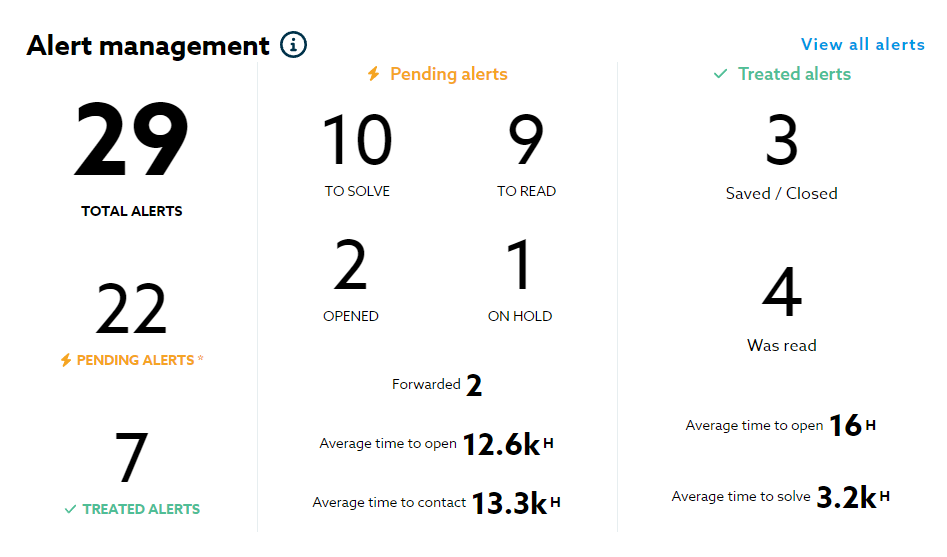Accessible from the Burger menu “Alerts” section or the Overview tab, the Pending Alerts and Alert Management module gives you a statistical overview of alerts. It shows the number of alerts to be processed and the number of alerts processed, as well as the average processing time.
- The View All Alerts link allows you to access and follow up on all alerts.
- The Pending Alerts will allow you to access all the alert issues that need immediate attention.
Then simply click on the View link to display the Alert Details view without having to open the PDF of the questionnaire. (you will have the choice of viewing All the Alerts or just the Pending Alerts)
- Defining and setting up alerts
An alert is issued when a questionnaire displays an NPS score or a percentage of Overall Satisfaction less than or equal to a specified value. Each organization decides what this value is and whether it wants the value to apply to the NPS and/or Overall Satisfaction before launching the survey.
- Access to Alert management
From the burger menu Alerts you can select the All tab or from Overview, you can access Alert management using the link View all alerts displayed in the Alert Management module. Click on the link to open the Details view that includes the Alerts only checkbox.
From the Detailed view, under the Pending or All tabs you can select an Alert from to column to access only the questionnaires that have triggered an alert. At any time, you can apply a filter to the table by Point of service or by region.
The Alerts column allows you to view the status of alerts.
Then simply click on the View link to display the Alert Details view without having to open the PDF of the questionnaire.
However, if you wish to open the PDF of the complete questionnaire, click on its icon either from the Alert Details page or in the table list of alerts.
- Understanding Alerts and Alert statuses
- To be resolved: The customer wants to be contacted. The branch must take action.
- To be read: The customer does not wish to be contacted. No action should be taken to contact the customer. The branch should only be informed of the alert.
- Open: The alert has been opened but not been read or resolved yet.
- On Hold: The status has been modified to be put aside and viewed or responded to at a later time.
- Pending: Status changed in the alert. The branch is waiting to resolve the alert (e.g., message left for the customer).
- Solved: The “To be resolved” alert has been resolved. The branch has taken action to manage the customer’s dissatisfaction.
- Read: The “To be read” alert has been read. The branch has taken stock of the elements related to the dissatisfaction
- Closed: Using the Closed status identifies that the Alert is finished of being taken care of and will not be addressed further.
- Transfer of an alert (Forwarded): Any alert can be transferred to the head office. The email address used for this alert transfer is chosen by you prior to the launch of the survey.
- Average time to Open: Time the alert was sent by email and then marked as open.
- Average time to Contact: The average time it took between when the Alert was first opened until it was sent to the customer.
- Average time to solve: The average time it takes before the issue becomes solved. This stat is tracked from the first time the alert is accessed until it has been set to solve.
Pending Alerts

Alert Management

Note: This module accounts for location filters but not the period filter for current alerts.
